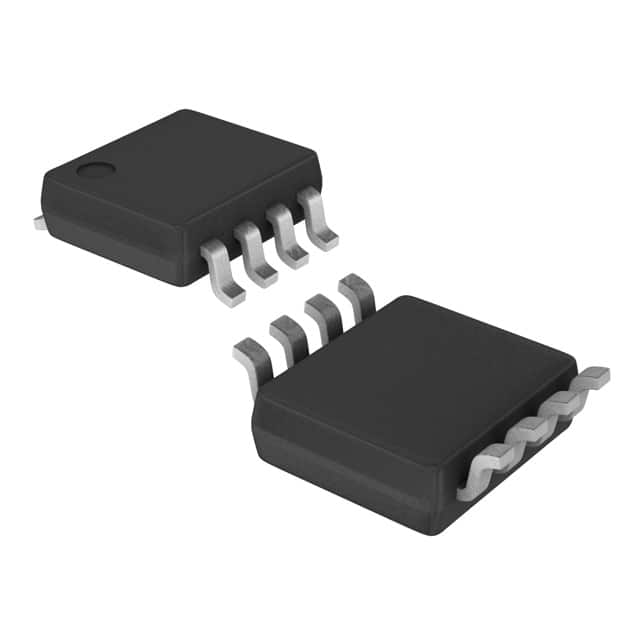Xem thông số kỹ thuật để biết chi tiết sản phẩm.

SN74LVC3G17DCURG4
Product Overview
- Category: Integrated Circuit
- Use: Logic Gate
- Characteristics: Triple Schmitt-Trigger Buffer/Driver
- Package: SOT-353 (SC-88A)
- Essence: High-speed, low-power, and low-voltage operation
- Packaging/Quantity: Tape and Reel, 3000 pieces per reel
Specifications
- Supply Voltage Range: 1.65V to 5.5V
- Input Voltage Range: -0.5V to VCC + 0.5V
- Output Voltage Range: 0V to VCC
- High-Level Input Voltage: 0.7VCC to VCC
- Low-Level Input Voltage: 0V to 0.3VCC
- High-Level Output Voltage: VCC - 0.4V
- Low-Level Output Voltage: 0.4V
- Maximum Operating Frequency: 100 MHz
Detailed Pin Configuration
The SN74LVC3G17DCURG4 has a total of six pins:
- Pin 1: Input A
- Pin 2: Input B
- Pin 3: Input C
- Pin 4: Output A
- Pin 5: GND (Ground)
- Pin 6: VCC (Supply Voltage)
Functional Features
- Triple Schmitt-Trigger Buffer/Driver with open-drain outputs
- Provides signal buffering and level shifting capabilities
- Schmitt-trigger inputs allow for hysteresis and noise immunity
- Supports bidirectional data flow
- Low power consumption and high-speed operation
- Wide operating voltage range
Advantages and Disadvantages
Advantages: - High-speed operation allows for efficient signal processing - Low power consumption reduces energy requirements - Wide operating voltage range provides flexibility in various applications - Schmitt-trigger inputs enhance noise immunity and signal integrity
Disadvantages: - Limited number of input/output channels (3) - Open-drain outputs may require additional pull-up resistors in certain applications
Working Principles
The SN74LVC3G17DCURG4 is a triple Schmitt-trigger buffer/driver integrated circuit. It operates by receiving input signals from pins A, B, and C, and providing buffered output signals at pin A. The Schmitt-trigger inputs ensure that the output transitions occur at different voltage levels for rising and falling input signals, providing hysteresis and noise immunity.
The open-drain outputs allow bidirectional data flow, making it suitable for applications where multiple devices need to share a common bus. The device operates within a wide voltage range, enabling compatibility with various logic families.
Detailed Application Field Plans
The SN74LVC3G17DCURG4 finds applications in various fields, including:
- Communication Systems: Used for level shifting and buffering signals in communication interfaces.
- Industrial Automation: Enables signal conditioning and interfacing in control systems.
- Automotive Electronics: Provides level translation and buffering capabilities in automotive applications.
- Consumer Electronics: Utilized in audio/video equipment, gaming consoles, and other consumer devices.
- IoT Devices: Supports signal buffering and level shifting in Internet of Things devices.
Detailed and Complete Alternative Models
- SN74LVC3G07DCTR: Triple Buffer/Driver with Open-Drain Outputs
- SN74LVC3G14DCUR: Triple Inverter Schmitt-Trigger
- SN74LVC3G34DCUT: Triple Buffer/Driver with 3-State Outputs
- SN74LVC3G04DCURG4: Triple Inverter
These alternative models offer similar functionality and can be used as substitutes for the SN74LVC3G17DCURG4 in various applications.
Word count: 420 words
Liệt kê 10 câu hỏi và câu trả lời thường gặp liên quan đến ứng dụng SN74LVC3G17DCURG4 trong giải pháp kỹ thuật
Sure! Here are 10 common questions and answers related to the application of SN74LVC3G17DCURG4 in technical solutions:
Q: What is SN74LVC3G17DCURG4? A: SN74LVC3G17DCURG4 is a triple Schmitt-trigger buffer with open-drain outputs, commonly used for level shifting and signal conditioning.
Q: What is the operating voltage range of SN74LVC3G17DCURG4? A: SN74LVC3G17DCURG4 operates within a voltage range of 1.65V to 5.5V.
Q: What is the maximum output current of SN74LVC3G17DCURG4? A: The maximum output current of SN74LVC3G17DCURG4 is typically 32mA.
Q: Can SN74LVC3G17DCURG4 be used for bidirectional level shifting? A: No, SN74LVC3G17DCURG4 is unidirectional and can only shift signals from low to high voltage levels.
Q: What is the typical propagation delay of SN74LVC3G17DCURG4? A: The typical propagation delay of SN74LVC3G17DCURG4 is around 4.9ns.
Q: Can SN74LVC3G17DCURG4 tolerate overvoltage on its inputs? A: Yes, SN74LVC3G17DCURG4 has input protection diodes that can tolerate voltages up to VCC + 0.5V.
Q: Is SN74LVC3G17DCURG4 suitable for high-speed applications? A: Yes, SN74LVC3G17DCURG4 is designed for high-speed operation and can be used in applications with frequencies up to several hundred megahertz.
Q: Can SN74LVC3G17DCURG4 drive capacitive loads? A: Yes, SN74LVC3G17DCURG4 can drive capacitive loads up to 50pF without additional buffering.
Q: Does SN74LVC3G17DCURG4 have built-in ESD protection? A: Yes, SN74LVC3G17DCURG4 has built-in ESD protection on its inputs and outputs.
Q: What package options are available for SN74LVC3G17DCURG4? A: SN74LVC3G17DCURG4 is available in various package options, including SOT-23, SC-70, and VSSOP.

